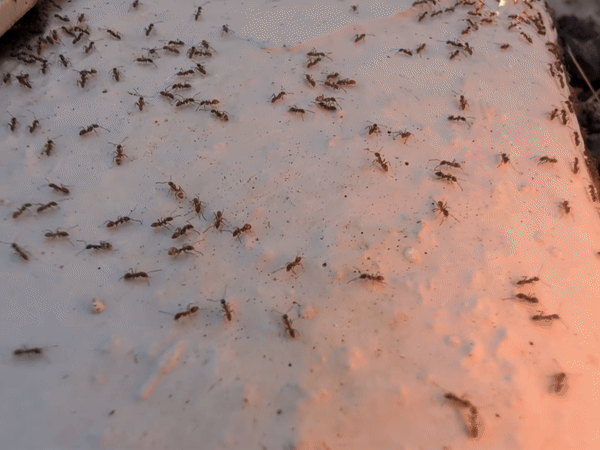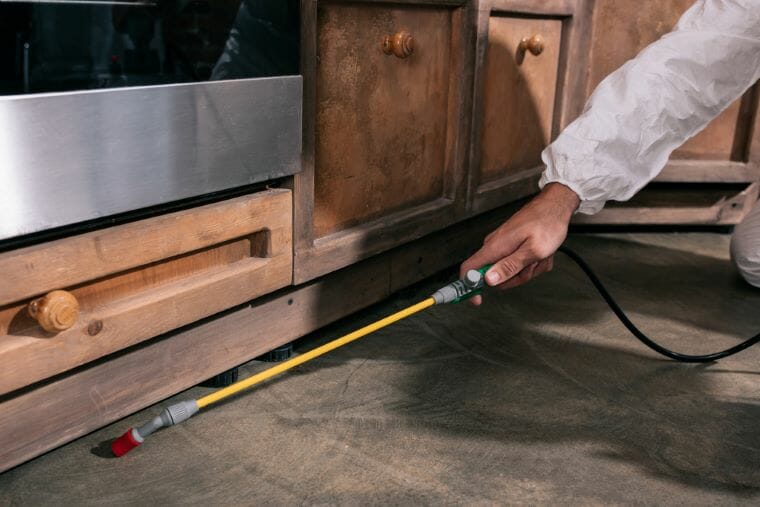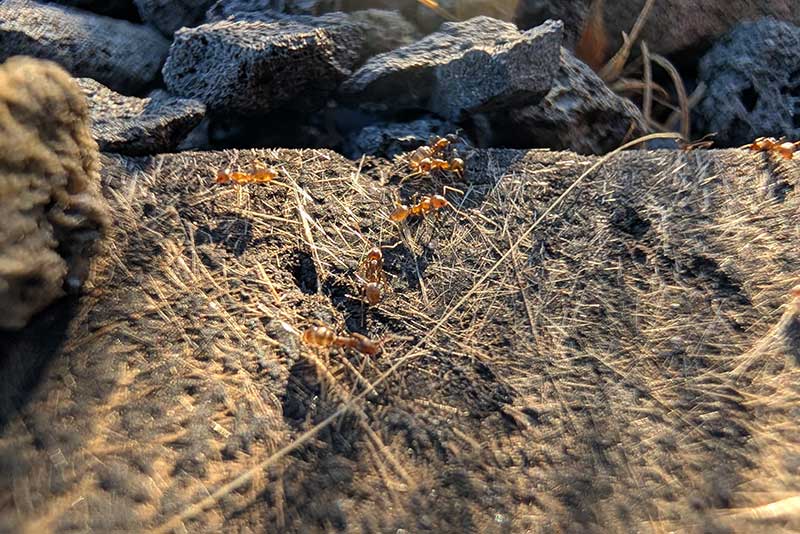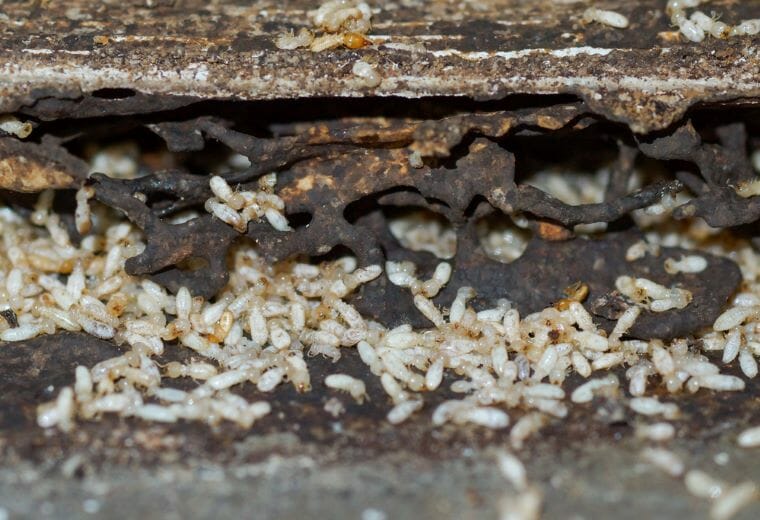Ants are a common household pest. With about 1,000 species of ants in the country, most homeowners run into an ant problem at one point or another.
Here at Smith’s Pest Management, our team offers pest control services to customers in the San Francisco Bay Area and the Central Coast in California.
And in this post, we’re sharing our top tips for eliminating ants once and for all.
Key Takeaways
- Ants are attracted to food, water and shelter inside your home. They forage on everything edible, are drawn to any type moisture and slip indoors through tiny access points.
- To get rid of ants, you can use natural remedies like diatomaceous earth, detergents, pepper, essential oils, white vinegar, baking soda, chalk, citrus fruits, salt, cornstarch, and boric acid, or chemical methods such as ant baits, traps, and sprays. Additionally, outdoor methods include boiling water, barrier sprays, and ant granules.
- Professional pest control services use a multistep process to eliminate ants. Technicians identify food and water sources and monitor colony activity. Industry-proven methods are used to destroy the queen and the colony.
Before You Begin

1. Conduct an Inspection
Start by checking out your property for any signs of ants.
Look closely at spots where they might be trailing or nesting, especially along seams, edges, and around buildings.
Early morning or dusk is a great time to spot ant trails since they tend to be more active when it’s cooler.
Don’t forget to check areas where they might like to hang out, like under bricks, stones, firewood, or standing water.
Additionally, keep an eye on the trees and shrubs around your property.
Look for ants moving up and down the trunk, which might mean there are aphids or other bugs around that produce honeydew, which ants love!
2. Be Conscious About Pesticide Use
While pesticides may seem like the fastest and easiest way to kill ants, using too much can be dangerous.
California Department of Pesticide Regulation advises on using pesticidal sprays for ant control only as a last resort.
With this in mind, use pesticides sparingly and only where you see ants.
Focus on baseboards, cracks, and spots where ants have been spotted.
Also, steer clear of spraying near food or eating areas.
3. Set the Stage
Keep your home clean to eliminate food sources for ants.
Pay special attention to cleaning up crumbs and spills indoors and getting rid of debris and firewood outside your home.
This removes food sources and hiding spots that can lead to ant infestations.
4. Decide Whether to DIY or Hire a Professional
When deciding whether to tackle ant removal yourself or hire a professional, consider your skills and the severity of the infestation.
If it’s small, you may be able to handle it on your own. If it’s extensive or widespread, though, you’d be better off hiring a professional.
Indoor Ant Control Methods
Naturally, with Home Remedies
So, you’ve got an ant infestation. What’s your next step?
Basically, you have two options: you can DIY it or call in the professionals. Be advised, though, that not all methods are created equal: while the DIY methods may work for killing a few visible worker ants, most ant colonies have tens of thousands of members, and there can be multiple colonies in any given yard.
If you want to eliminate the infestation completely, you’ve got to kill the colony and the Queen.
The best way to do that is to focus on preventative treatments (we’ll offer tips on this later in this article) and invest in professional ant control services.
If you’re still dedicated to the DIY approach, here are a few options you can try:
1. Diatomaceous earth (silicon dioxide)
Diatomaceous earth (DE, for short) is a type of silica dust made from the pulverized, fossilized remains of ancient aquatic organisms called diatoms.
DE is not poisonous. Instead, it kills ants and other pests by pulling oil from their skeletons and drying them out. To kill ants with DE, just sprinkle the powder anywhere you see ants entering or moving through your home.
Pros: Effective, natural, safe for pets and people
Cons: Can be messy, pets may track DE dust throughout the house, DE can be a skin and respiratory irritant, requires reapplication, does not kill the colony or the Queen
2. Detergents
Household detergents, like hand soap, glass cleaner, or liquid detergent, can deter ants from entering your home. Remember: ants have poor eyesight, and they rely on the scented pheromone trails they leave behind to navigate the world.
Fortunately, household detergent removes these trails and helps keep ants out. For best results, mix detergent with water and scrub the surface with soapy water. You can also use store-bought glass cleaner in the same way.
Pros: Easy, safe and non-toxic
Cons: Requires manual application and regular re-application, only kills visible worker ants – not the colony or the Queen
3. Pepper
Ants rely on their sense of smell to navigate the world, and they find the scent of pepper irritating.
To deter them from entering your home, sprinkle ground black or red pepper around your baseboards and behind appliances.
Pros: Affordable, safe
Cons: Can be an irritant for kids and pets, may be messy, requires regular re-application, does not kill ants
4. Essential Oils
Peppermint, cinnamon leaf, lemon, neem, eucalyptus, thyme oil, lemongrass oil, and tea tree oil are natural ant repellants that can help keep ants out of your house.
For best results, mix a few drops of essential oil into 2 cups of water and spray the mixture around the baseboards, windows, and doors of your home.
Pros: Affordable, easy, safe for children
Cons: Can be irritating to pets, especially cats
5. White vinegar
If you see ants in your home, mix up a solution of 50-50 vinegar and water and wipe the ants up with it.
This kills existing ants and repels future ones by leaving a lingering scent of vinegar, which is a natural ant repellant.
Pros: Easy, affordable, effective
Cons: May not be safe for all surfaces, leaves behind a vinegar smell, must be reapplied consistently, does not kill any ants besides the visible workers
6. Baking soda (or borax)
Ants and baking soda don’t mix. In fact, Baking soda and borax will both kill ants upon ingestion.
For best results, mix equal parts baking soda or borax for ants and confectioner’s sugar and place it into a shallow container where ants can reach it.
Pros: Effective, easy
Cons: May attract kids or pets and can be toxic for both, does not kill the colony or the Queen
7. Chalk
Chalk contains calcium carbonate. When placed in a thick line, calcium carbonate can confuse an ant’s scent trail, making it more difficult for them to pick up the scent of other ants and confuse the pests.
For best results, draw a thick, heavy line of chalk around the areas you’d like to protect, such as a picnic table or barbeque.
Pros: Affordable, easy
Cons: Not a long-term solution (will only keep ants away for a while), must be reapplied after rain or watering, does not kill ants that remain in the colony
8. Oranges or lemons
Citrus fruits, specifically orange or lemon rinds, contain an extract known as d-limonene, which is toxic to ants. Instead of throwing out those orange peels, keep them and turn them into a homemade ant repellent. Here’s how:
Dump discarded orange peels into a gallon jar. For best results, fill the jar halfway with peels and the rest with water. Seal the jar and place it in a dark place for 3-5 days until the water is colored.
Strain the liquid, dump it back into the jar, and add a teaspoon of molasses and a single squirt of dish soap. Mix the liquid well, place it in a spray bottle, and spray it directly on ants when you see them.
The citrus oil will kill the ants on contact. You can also use this orange oil extract to eliminate ant trails, so be sure to spray it anywhere you’ve noticed ant activity.
Pros: Affordable, easy to use, non-toxic for kids, pets, and other animals
Cons: Can create a sticky residue, can be time-consuming to make, will only kill worker ants, will not wipe out the colony
9. Salt
Salt can be an effective, natural ant killer if you use it correctly. For best results, mix a cup of Epsom salt into a spray bottle of water and spray it directly on ants whenever you see them.
The salt will kill the ants through dehydration without harming non-target species.
Pros: Epsom salt is safe to handle and won’t harm kids, pets, or other animals
Cons: You’ll need to reapply the salt regularly and it still won’t drastically reduce ant populations. This method only works if you spray it directly on ants.
10. Cornstarch
Cornstarch, which you probably have in your kitchen already, is an effective ant killer. You can either pour cornstarch over an entire group of ants and dump water on top or cover the ants with cornstarch and vacuum them up.
If you choose the first option, you’ll need to wipe up the dead ants and cornstarch and dispose of them. If you choose the second option, make sure to dispose of the contents of your vacuum canister immediately.
Pros: Effective, non-toxic, fast
Cons: Can be messy, requires more cleanup than other methods, only kills worker ants
11. Boric acid
Boric acid will kill worker ants and the colony’s queen within three weeks of exposure. To use it effectively, make a solution containing ½ teaspoon of boric acid, eight teaspoons of sugar, and 1 cup of warm water.
Stir the mixture until the boric acid is dissolved. Saturate cotton balls in the solution and place them anywhere you’ve noticed ant activity.
Pros: Affordable, effective
Cons: Boric acid can be dangerous for kids and pets, so the solution and cotton balls must be kept out of their reach
12. Vacuuming
Vacuuming disrupts ant trails and removes both visible ants and their food sources. After vacuuming, wipe down the area with soapy water to eliminate the pheromone trails that guide other ants to the same location.
Start by using a vacuum with a hose attachment to thoroughly clean areas with ant activity. Pay special attention to kitchen counters, floors, and areas near food sources.
Immediately empty the vacuum bag or canister into a sealed plastic bag and dispose of it outside to prevent any ants from escaping.
Next, create a simple soapy water solution by mixing a few drops of dish soap with warm water. Use a clean cloth to wipe down the previously infested areas, breaking down the trails ants use to communicate and navigate.
Pros: Immediate removal of ants, disrupts colony communication, no harmful chemicals
Cons: Temporary solution, requires consistent effort, may not eliminate entire colony
With Chemicals

We’ve already discussed a few natural ways to get rid of ants and why those options are not the most effective—they don’t wipe out the colony or the queen.
Instead, they only kill the occasional visible worker here and there.
If you really want to wipe out ant infestations, you’ve got to use a treatment that the workers can carry back to the colony and feed to the queen.
With all of that in mind, here’s what we recommend:
12. Baits
Ant baits are small, covered pods that you place in areas the ants have been trafficking. The pods contain concealed poison, which the ants access and carry back to their colony.
This strategy works because ants have a complex social structure centered around food sharing, with worker ants systematically distributing food to their entire colony, including larvae and the queen.
When ants in the colony consume the poison, it kills them.
For best results, place gel baits or bait stations in areas where you notice ants, like along foraging trails inside or in cracks.
Try using non-repellent insecticides, such as Alpine WSG, for ants.
These insecticides are great because they don’t deter ants – instead, they attract ants and encourage them to carry the poison back to the colony.
Additionally, use liquid or granular ant baits outdoors, and always keep repellent insecticides away from the bait since they can contaminate the bait and prevent ants from bringing the bait back to their colony.
Pros: Effective, Affordable
Cons: Can be dangerous for kids and pets, requires regular checking and replacement
“First things first, follow the trail to the source and treat those ant mounds directly. It’s like playing detective but with a much more satisfying ending. Seal up any cracks where they’re sneaking in with some good old caulking. And don’t forget to set out ant bait from your local hardware store.” – Zachary Smith, owner of Smith’s Pest Management.
13. Traps
Ant traps work like baits, except that they trap ants and do not allow them to leave. These traps may also contain poison, which kills ants rapidly.
Pros: Affordable, effective
Cons: Must check the traps regularly and dispose of dead ants
14. Sprays
Ant spray is available for both indoor and outdoor use. It kills ants on contact and can make quick work of an ant problem.
To treat the outside of your home, spray the pesticide around the foundation, about two feet up and three feet out, to create a complete barrier.
Pros: Effective, fast-acting
Cons: Contains toxins and is not safe for use around kids or pets, kills ants on contact, which means it is not a permanent solution
Outdoor Ant Control Methods

We’ve talked about getting rid of ants indoors, but maybe you’re wondering how to get rid of ants in your garden without killing any of the plants you have. Here are our top tips:
1. Boiling water
Boiling water is an easy, effective way to kill ants immediately. If you see ants emerging from a crack in the concrete or a hole in the ground, pour boiling water into the area.
This will kill many of the ants within it. Just make sure you’re not pouring boiling water on your plants or their roots since this will kill them, as well.
Pros: Effective, safe, easy
Cons: Requires regular re-application
2. Barrier sprays
Outdoor barrier sprays can be applied along the foundation line of your home. These sprays kill ants on contact and provide long-acting ant prevention.
You can purchase them at your local home and garden store or hire a pest management company like Smith’s to provide professional-grade sprays.
Pros: Effective, long-lasting
Cons: Requires regular re-application, toxic, not safe for kids, pets, or other animals, may kill beneficial insects, as well
3. Ant granules
Ant granules work like deconstructed bait stations. The granules are placed around your home’s exteriors, where ants consume them and die on contact. This is a great option for eradicating outdoor ant infestations since the workers will take it back to the nest and feed it to the queen, which will help get rid of the ants you can’t see.
Pros: Effective, affordable, DIY-friendly
Cons: Toxic, dangerous for kids and pets, requires re-application
How Do Exterminators Get Rid of Ants?

Professionals like Smith’s take ant infestations seriously.
If you have ants in your home, here are the steps our team will take to get rid of them:
1. Inspection
Our first step is to conduct a thorough inspection of your property.
During this phase, we’ll determine what kinds of ants you have, where they’re coming from, and what the best course of action is to deal with them.
We’ll also identify any potential food sources and eliminate them.
2. Monitoring
Even if you see individual ants in your home or garden, the colony is probably much more extensive than you imagine.
We’ll monitor the ant activity to ensure we know where they’re coming from and where the main colony is. To ensure we get rid of all the ants, we’ll trace the ants back to the colony, locate entry points in the structure, and identify all known hives or colonies.
3. Control
Finally, we place out carefully designed baits in hidden places that the ants will feed on and bring back to the hive.
Sometimes we will also apply carefully directed sprays along the trail of ants that they will also track back to the hive.
The goal is to kill the queen and the brood and get rid of all ants once and for all.
Since it’s impossible to kill the ants in your neighborhood (and a neighbor’s colonies can easily infest your property), recommend ongoing maintenance treatments to keep ant populations low.
Prevention Tips

The best way to deal with an ant infestation is to prevent it in the first place.
These simple tips will help dissuade ants from entering your home:
- Clean up all food spills and messes promptly to prevent ants in the kitchen.
- Store ripe fruit in the refrigerator and other foods (like sugar, crackers, and other non-perishables) in airtight containers.
- Inspect and seal potential entry points like window frames, door thresholds, and foundation cracks using caulk or weatherstripping to create a barrier that prevents ants from accessing your home’s interior.
- Dry the tub or sink after each use and plug the drain with a stopper.
- Check under sinks and other appliances for leaks and fix any moisture problems immediately.
- If you have ants in your pantry, place condiment jars inside gallon plastic bags.
- Clean pet bowls often and wipe up any spilled food or water promptly.
- Inspect indoor potted plants for insect activity often.
- Keep brush, shrubs, mulch, and other organic materials at least three feet away from your home’s foundation.
- Keep your gutters and downspouts clean and free of debris. This eliminates standing water that may attract ants.
- Clean the inside of your toaster or toaster oven, and wipe and empty the crumb tray after each use.
- Use can liners in your indoor trash cans. Keep the lids tightly closed and clean both the inside and outside of the can with bleach regularly.
- Rake mulch and landscaping materials back to at least 6” from your home’s foundation.
- Store outdoor trash bins at least 10 feet from the house and wash them monthly with an ammonia solution.
- Consider sprinkling some cinnamon or cayenne pepper if you have ants in the garden or in highly trafficked areas to deter them.
- Remove harborage areas like piles of debris or firewood from the exterior of your home.
Need More Help? Turn to Smith’s!
We know an ant infestation can be frustrating and troubling. Fortunately, you don’t have to deal with it on your own!
Here at Smith’s Pest Management, we serve homeowners and businesses from Marin, CA to Monterey, CA and we specialize in ant control services to help you get life back to normal.
Contact us today to get a free quote and let us help you get rid of ants once and for all!
FAQ
What attracts ants?
1. Food
Ants eat almost anything people do. While they’ll consume any leftover food scraps or crumbs, they’re especially attracted to sweets.
Sticky jam residue left behind on the counter, a drop of honey, or a discarded lollypop are all excellent sources of nutrients for ants.
And once even one ant finds the source of this sweetness, they’ll leave behind a scent trail to attract the rest of the colony.
The result is a massive ant infestation in no time.
2. Moisture
Ants need food and water to survive. Unlike most animals, though, ants don’t just drink on an “as needed” basis. They also take water back to the colony to store it for future consumption.
When they find a good water source, they’ll leave a scent trail to alert the rest of the colony.
As such, broken pipes, potted plants, accumulated condensation in bathrooms, and water bowls for pets can all attract nearby ants.
3. Shelter
While ants are small enough that they can find shelter virtually anywhere, they like to build a colony inside a warm, cozy home if they can.
If ants can find an access point to your home (a crack in your weather-stripping or caulk, for example), they’re happy to come inside.
What type of ants are in my home?
As we mentioned earlier, there are about one thousand different species of ants in this country alone.
Here are a few of the most common ants you’re likely to see in your kitchen, bathroom, or garden:
Carpenter ants
Carpenter ants are common outside the home.
While carpenter ants don’t eat wood (a common misconception), they do tunnel through wood to build their nests and colonies, so you may see them around your deck, or garden, or on the siding of your house.
Although these ants are tiny (only ¼ to ½ inches long), they can cause severe structural damage to buildings, so it’s critical to promptly deal with them.
These ants live in colonies and are most active after dusk. They subside on a diet of sugar and protein and will eat anything from human food scraps to pet food.
Pavement ants
If you’ve seen a line of tiny black ants marching under the front door and toward your kitchen, they’re likely pavement ants.
These ants, also known as “sugar ants,” have small bodies that are brown or black. As the name implies, pavement ants build their homes in pavement cracks. They forage for their food and often make their way indoors to do so.
Once they’re in your home, they’ll frequent your pantry, kitchen, or any place else they can find food scraps.
Argentine ants
Argentine ants live throughout the U.S. but are particularly common in the urban areas of California. They are light or dark brown and can be between 2.2-2.8 mm long. These ants build elaborate nests in fibrous materials like wood, debris, mulch, or the cavities of shrubs and trees.
If you see one Argentine ant, chances are it’s a sign of a much larger infestation. A single colony of these ants often consists of multiple nests and may contain more than one hundred queens. Argentine ants are an aggressive species and will conquer and kill other ant colonies nearby.
When the weather gets too dry or too wet for these ants, they tend to seek shelter indoors, making their way into your home to nest in your walls or under your floorboards.
Fire ants
Fire ants are common in Southern states throughout the U.S. While their bodies are small (then tend to be dull, red-brown in color, and have a visible stinger on the back section of their abdomens), their bites and stings are extremely painful – hence their name.
When the fire ant stings, it injects venom into its victim, causing a sharp burning sensation. Immediately after the sting, the affected area will break out in red bumps. Within 24 hours, the bumps will become white, fluid-filled pustules.
Fire ants are considered an invasive species. They first arrived in the U.S. from South America in the 1930s. Since then, their population has boomed. There are currently five times more fire ants per acre in the U.S. than there are in South America.
Although fire ants prefer to build their nests and colonies outside, they will venture inside the home if they can find an access point.
Harvester ants
Harvester ants are one of the larger types of ant in California. The workers are ¼-½” long, with red or dark brown bodies. They have square heads and spineless bodies. Outdoors, harvester ants will remove vegetation in the circular area surrounding their colonies or nests.
You may also notice bare patches of lawn surrounding the nest—these are the foraging trails the ants rely on for food.
Odorous Ants
Odorous ants are small, typically 1/8″ long, with dark brown or black bodies that emit a distinctive rotten coconut-like smell when crushed.
These ants are common household invaders, often found in kitchens and bathrooms, and are particularly attracted to sweet foods and moisture.
Their colonies can be large, with multiple queens, making them challenging to eliminate completely.
Do I have an ant or termite infestation?

While ants and termites may live in some of the same areas and can both cause damage to your home, they are not the same creatures.
Here’s a breakdown of the key differences:
Ants
- Elbowed antennae
- Pinched waist
- Black, brown, or reddish bodies
- If wings are present, front wings are longer than hind wings and are typically brown
Termites
- Straight antennae
- Front and hind wings are similar in length and shape and tend to be pale or translucent
- The body extends from the head in a straight line, with no pinched waist
- White to light brown bodies


